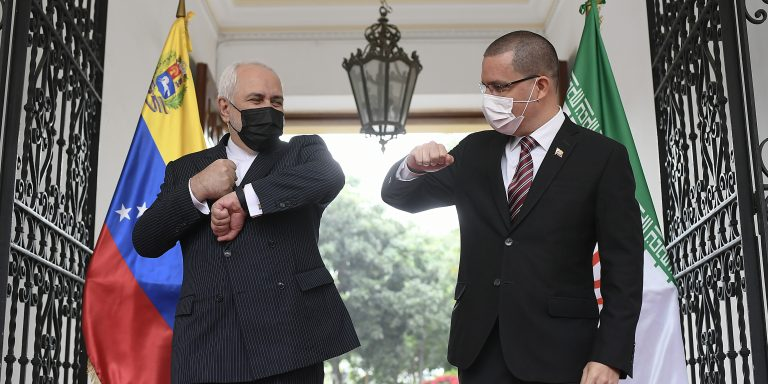
Iran and Venezuela appear to be expanding military ties, even beyond joint efforts to evade U.S. economic sanctions.
An Iranian flotilla carrying drones, assault helicopters, and fast-attack boats has entered the Atlantic Ocean, apparently bound for Venezuela.
Iran’s possible introduction of drone technology to Venezuela would enhance Iran’s efforts to project hard power into the Western Hemisphere.
The Biden administration has not announced a U.S. strategy to counter any Iranian military buildup in Venezuela or other areas close to the U.S.
On June 10, Iranian military commanders said that two Iranian Navy ships had entered the Atlantic Ocean, and, according to U.S. officials, their most likely destination is Venezuela. The Iranian ships include a frigate and the Makran, a former oil tanker that was fitted with a launch platform for helicopters and other craft useful for electronic warfare and special operations missions. It reportedly has advanced missile and weapons capabilities and can carry drones and six to seven helicopters. Some reports say that the Makran also carried fast attack craft, presumably for use by Venezuela or by Iran in the Caribbean. The buildup suggests that Iran is seeking to implement in the Western Hemisphere the same strategy Iran has employed to significant effect in the Middle East – the arming and advising of allies and proxies that are in position to strike at Iran’s adversaries. In past years, Iran had few governmental allies in Latin America, and it projected power there primarily by sponsoring terrorist attacks, including Lebanese Hezbollah’s bombing of Israel’s embassy and a Jewish cultural center in Buenos Aires, Argentina in 1992 and 1994, respectively.
The expansion of the military dimension of Iran-Venezuela relations builds on the economic ties that grew closer in 2020 as part of their joint efforts to thwart the Trump administration’s “maximum pressure” policy toward both governments. U.S. policy was openly intended to bring down Maduro’s regime and, in the case of Iran, to weaken that country strategically and perhaps cause its collapse. U.S. policy toward both countries centered on the enforcement of comprehensive economic sanctions, and Iran and Venezuela calculated that joining forces would help them thwart U.S. strategy. During 2020, a few flotillas of Iranian tankers carried gasoline and petrochemical products to Venezuela. The shipments helped the Maduro government cope with U.S. sanctions and domestic energy sector mismanagement that had caused Venezuela’s oil refining capacity to collapse and the government to institute fuel rationing. In exchange, the Maduro government paid Iran hundreds of millions of dollars in gold, which were flown to Tehran. The gold helped Iran confront a cash crunch that resulted from U.S. sanctions, which prevent Iran from accessing its financial assets held in banks around the world. The gasoline-for-gold trading violated U.S. sanctions on both countries.
The expanding Iran-Venezuela military relationship complicates the threat profile facing the Biden administration well beyond their joint actions against U.S. sanctions. Admiral Craig Faller, the commander of U.S. Southern Command (responsible for U.S. military operations in Central and South America) has described Iran’s growing military presence in Venezuela, including personnel from Iran’s Islamic Revolutionary Guard Corps’ Quds Force (IRGC-QF), as “alarming.” A National Security Council spokesperson noted that any new delivery of weapons “would be a provocative act and a threat to our partners in this hemisphere.” The official added: “We would reserve the right to take appropriate measures — in concert with our partners — to deter the delivery or transit of such weapons.”
The Biden administration remains wary of taking actions that could derail talks with Iran on a return to the 2015 multilateral Iran nuclear deal. Just this week, a U.S. defense official said there are currently no plans to send U.S. Navy ships to monitor or deter the Makran task force. The Administration reportedly has privately urged the governments of Venezuela and Cuba to turn away the Iranian ships, although whether either country would heed that warning is unclear. The primary missions of U.S. naval forces in the Caribbean are to combat narcotics smuggling and illegal immigration and conduct maritime rescue. An Iranian naval presence in the Atlantic Ocean and Caribbean Sea could divert heavier U.S. naval assets and U.S. intelligence assets from missions outside the hemisphere. Venezuela’s neighbors, most of which support U.S. efforts to oust Maduro, would likely request additional U.S. support in reaction to the introduction of an Iranian drone threat in South America. It is difficult to predict with certainty how U.S. officials might respond over the longer term if Iran succeeds in applying its proxy warfare approach against the United States and its allies from the Middle East into the Western Hemisphere.
